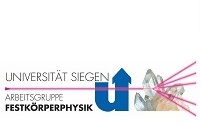Figures
This page demostrates the figures from our recent research articles and presentations.
Some of these Figures are also available in the form of animations
 |
| Schematic view of time-resolved X-ray diffraction experiment based on a multi-channel analyser. A cyclic perturbation (electric field, magnetic field, force, laser beam) of an arbitrary waveform and frequency is applied to a sample. The generator of external perturbation provides clock pulses: each pulse marks the beginning of a perturbation cycle. The clock pulses, detector pulses, and the information from a diffractometer position encoder are introduced into a multi-channel analyser unit which redistributes detector counts between multiple time channels. The system is desgined, developed and maintained in collaboration with the electronic lab of the University of Siegen |
 |
| Time-resolved X-ray diffraction measurement of the 007 Bragg rocking curve (RC) of Sr0.5Ba0.5Nb2O6 single crystal under sub-coercive electric field cycling. (a) False-colour map of the intensity as a function of time and relative rocking angle. (b, c) RCs, corresponding to four selected time channels. The dashed lines mark the position of their mass centers, highlighting the field induced change of the asymmetry. (d) Time dependence of the rocking curves positions (mass center and the position of the maxiimum). e) The amplitude of MC motion of 00l (l=3...7) RCs over the entire voltage cycle, plotted as a function of tanθ. For more details please refer the article in the Physical Review Letters |
 |
| X-ray diffraction from multi-domain crystals. (a-b) show the real space domain patterns (schematical drawing on the top and polarized light microscopy image of Na0.5Bi0.5TiO3 single crystal on the bottom), (c-d) show that low resolution reciprocal space of a multi-domain system consists of strongly overlapping reciprocal lattices. Although the fine structure of Bragg peaks, corresponding to the individual domains is evident, it is rather difficult to resolve. (e-f) demonstrates how the reconstruction of the high-resolution reciprocal space readily resolves them. |
 |
| Schematic illustration of two polarization reversal routes as 'seen' by time-resolved X-ray diffraction in Sr0.5Ba0.5Nb2O6 single crystal. The panels (a) and (b) show the results of time-resolved X-ray diffraction experiment: time-dependent rocking curve and polarization-electric field hysteresis loop. The panel (c) is interpretation. It shows our real space idea about switching routes. This first route follows the mechanics of a 'bulk' switching where a lattice strain scales with the square of polarization. The second route involves the formation of small domains and it passes over the maxima of the average (e.g. inside the domain wall) lattice parameter. For more details please refer the article in the Physical Review Letters |
